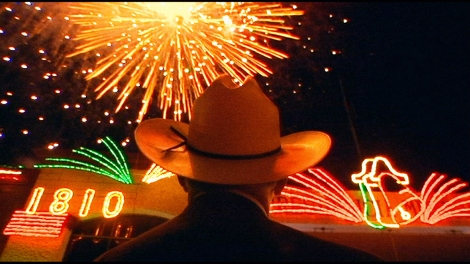
Ed. Note:
This is the introductory piece in a nascent essay column, Desert of the Real, by Ben Altenberg. Like it? Hate it? Reach out to the author through the contact form at the bottom of this page to let us know your thoughts.
*****
In the newly-released films I watched over the past year, the most prominent topic, adding up to four flicks, was the Mexican Drug War. I exited these screenings (three documentaries and one work of fiction) the same ignorant American outsider as when I sat down, though perhaps heavier with melancholy and sympathy for a swath of brutal violence that has consumed nations for several decades. I’m not a believer in feature films as information-delivery systems. When the lights go down and the projector starts blaring luminous magic on a 2-dimensional screen, I find it difficult to interpret the encounter with the infinite like an objective lecture.. Yet in the matter of these four films, the content became familiar enough that I discovered more profound messages in the way their forms reflected patterns and distortions of a culture and its actors off of one another. The ultimate vision never strayed from the aspect of a window that illuminated the absurd abstraction that these events were taking place in exotic lands far from my urban central Texas home, a lie that exposes the central cause of our society’s failure to empathize with and engage the plight of our neighbors.
Bernardo Ruiz’s documentary Kingdom of Shadows takes a tri-cornered character approach to an analysis of civilian disappearances in recent times by examining the lives of: a nun who spends her time consoling family members of the tens of thousands of missing persons whose bodies will likely never be found; a U.S. federal agent from El Paso with a refreshingly tolerant and informed perspective on border security; and a Texan man who spent years smuggling weed over the border before going to prison for some time. The dynamic between them remains compelling because their diverse opinions are not cobbled together to form a singular message.

Matthew Heineman’s Cartel Land takes a similar angle, though the result feels more exorcized. It uses the border as a mirror between two individuals committed to a vigilante ideal, one a populist paramilitary ‘hero’ against the cartels of Michoacán, and the other a minuteman-esque patriot who patrols a rural stretch of Southern Arizona on the lookout for mules and coyotes. The point at the end, which seemed obvious from the beginning, is that they become that which they were combatting. Denis Villeneuve’s dark thriller Sicario opts for a completely American perspective, anchoring its suspense upon the angst of being left in the dark. Its protagonist, FBI agent Kate Mercer, finds herself a pawn in a geopolitical maneuvering that assumes the horrors of Mexico to be inevitabilities which merit no moral compromise. Whether the focus is on the perpetrators, the victims, or the neutral observers, none escape the vacuum of helplessness.
The exception is the Ross brothers’ old-school, direct Western, which complements the hovering despair with the defiantly multicultural harmony of the Texas border town of Eagle Pass and its sister Mexican city, Piedras Negras. It is that distinctive focus that elucidates one of the more crucial themes underlying these narratives: the imaginary line with armed guards and stations all around it. Western is perhaps most committed to what Gogol Bordello articulated with its lyric, “borders are scars on the face of the planet.” The travails of Eagle Pass’s mayor in Western, who works tirelessly to battle the fallacy that small-town Texans are intolerant hicks, are speckled with the experiences of less-prominent denizens of the town. The increasing violence of the cartels remains a pall over them, but it is not the central tenet of their lives. This unembellished, straightforward depiction of life in a border town carries a unique brand of authenticity out of the four films because it serves to contextualize the despair within everyday lives. Even when murders hit closer to home, and the mayor’s own life appears at risk, the film’s tone refuses to commit to a sense of despondency.
Interestingly, Sicario’s narrative approach to the border practically evokes the same argument for its irrelevance – but only for one side of it. When enmeshed in a traffic gridlock at a check station, the CIA shadow group at the heart of the film finds itself in the midst of a cartel ambush. The scene’s tension quickly dissipates when they brutally dispatch their assailants without regard for procedure, and then depart the scene, and then the country, without looking back. While the corruption at the heart of Sicario is undoubtedly an exaggerated fiction, it is rooted in the indefatigable truth that that line matters to one side a lot more than it does the other.

The other motif that reveals much of ourselves is the creative depiction of violence. Sicario is the only film of the four to feature constructed action, none of which is any more “graphic” than your standard Schwarzenegger matinee. Like its nonfiction contemporaries, interestingly, it pauses to note the reality of the situation by showing actual photography of murders and beheadings. Mercer scans the images on Google, then eventually closes her laptop, overwhelmed with their stark brutality. Her engagement with shrouded enemies is as distant then as when she drives through Ciudad Juarez, witnessing the cartel’s leftovers through another separating frame. It seems that this editorial form is the only way to engage such imagery without feeling derogatorily exploitive.
Cartel Land is the only work that hinges its watchability on actual vérité gun violence, yet deems it necessary to amplify the harrowing effect with an action movie score. Despite this direct engagement with the turmoil, it still pulls back when it comes to anything beyond the sound of gunfire. As in the other films, there is the implication of something worse to come before an ominous fade to black. This arm’s length technique is hard to completely disagree with for the sake of everyone’s sanity; but it is, inevitably, a symptom of both the constraints of the medium and the quagmire’s insolubility.
It is not surprising that these works – essentially designed for an American audience – skew towards examinations of America’s role. At the same time, our broad propensity to value our national safety over that of our North American siblings is a rigid principle in dire need of scrutiny. Going forward, that’s the significant moral value I take from this happenstance cinematic trend. At the same time, there is a soft but profoundly disturbing chord strumming in the background of these images: the murderous hostility of cartels that paralyzes heroes into silence. Reporters and their ilk who dare to speak out against and directly expose the perpetrators of these slayings continue to find themselves victimized. The dark theater and its wide frame offers a “safe” window of agency for such voices. The choice to sit down, gaze, and listen to these cinematic pleas might seem a meek offering of support, but when the stakes are such that even those who speak their minds are in mortal danger, providing an audience appears no slender burden at all.
–Ben Altenberg

